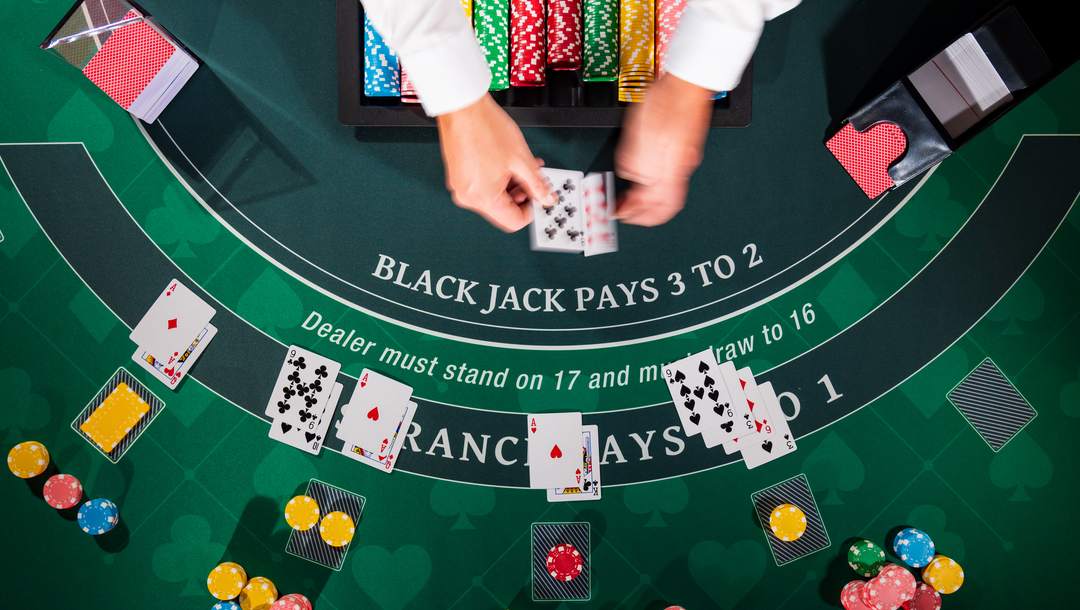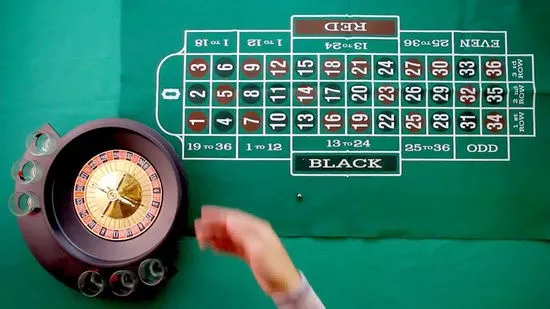Blackjack, also known as 21, is a popular card game played in casinos worldwide. It is known for its simple rules and the strategic decision-making involved in the gameplay. Here’s an overview of the classic blackjack game:
Blackjack Card Game:
Objective: The primary goal of blackjack is to beat the dealer by having a hand value closest to 21 without exceeding it. Each card has a point value, and players aim to build a hand with a higher total than the dealer’s hand without going over 21.
Card Values:
- Number cards (2 through 10) are worth their face value.
- Face cards (Jack, Queen, King) are each worth 10 points.
- Aces can be worth either 1 or 11 points, depending on which value benefits the hand more.
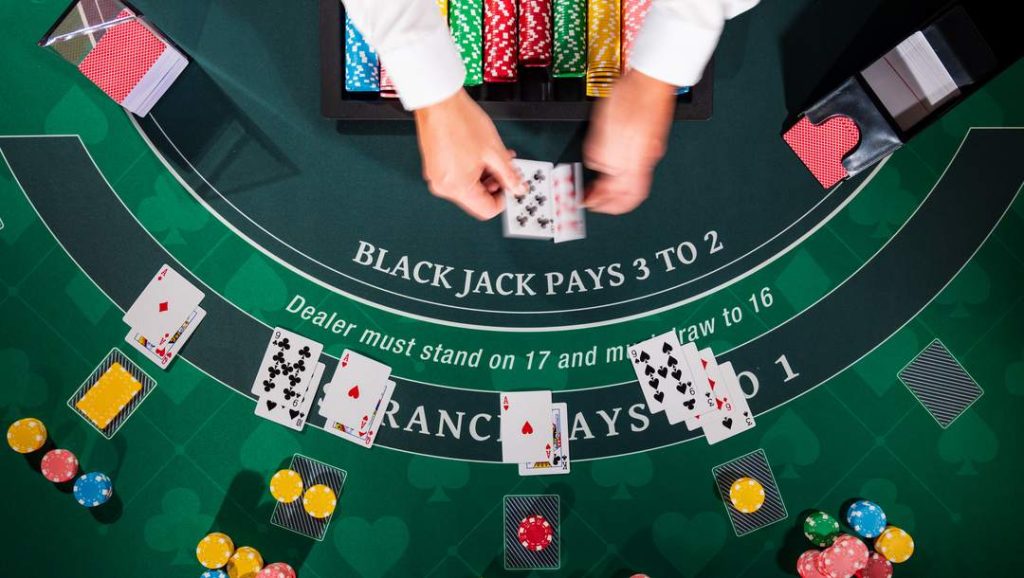
Gameplay:
- Dealing: Each player, including the dealer, is initially dealt two cards. Players’ cards are usually dealt face up, while one of the dealer’s cards is face up (known as the “upcard”), and the other is face down (known as the “hole card”).
- Player’s Turn:
- Players can choose to “hit” (take another card) to improve their hand.
- Players can “stand” to keep their current hand.
- Players can “double down” by doubling their original bet and receiving only one additional card.
- Dealer’s Turn:
- The dealer reveals their hole card.
- The dealer must follow specific rules regarding hitting and standing. For example, the dealer may be required to hit until they reach a certain point total (usually 17 or higher).
- Winning:
- If a player’s hand exceeds 21, they bust and lose their bet.
- If the dealer busts, all remaining players win.
- If neither busts, the hand closest to 21 without exceeding it wins. Ties result in a push (no win or loss).
Blackjack: A “blackjack” is the best hand, consisting of an Ace and a 10-point card. It usually pays out at a higher rate, often 3:2.
Insurance: Players can take insurance if the dealer’s upcard is an Ace. This is a side bet that pays 2:1 if the dealer has a blackjack.
Splitting: If a player is dealt two cards of the same rank, they can choose to split them into two separate hands, each played with a separate bet.
Double Down: Players can choose to double their original bet after the initial two cards, receiving only one more card in the process.
House Edge: The house edge in blackjack can vary based on the specific rules of the game being played. Generally, blackjack offers one of the lowest house edges among casino games when played with optimal strategy.
Blackjack is a game that combines luck and skill, making it a favorite among casino enthusiasts. Success in blackjack often involves making strategic decisions based on the cards in play.
The Objective of Blackjack
Beat The Dealer. There are some misconceptions about the objective of the game of blackjack but at the simplest level all you are trying to do is beat the dealer.
How do you beat the dealer?
- By drawing a hand value that is higher than the dealer’s hand value
- By the dealer drawing a hand value that goes over 21.
- By drawing a hand value of 21 on your first two cards, when the dealer does not.
How do you lose to the dealer?
- Your hand value exceeds 21.
- The dealers hand has a greater value than yours at the end of the round
It’s also important to note, the other players’ hands at the table have nothing to do with winning the game of Blackjack like they do in Poker games. For all practical purposes, it’s just you against the dealer. Unskilled patrons of the game will try to convince you “it’s a team sport” but don’t be fooled.
How Do You Find a Hand’s Total Value?
Blackjack is played with a conventional deck of 52 playing cards and suits don’t matter.
- 2 through 10 count at face value, i.e. a 2 counts as two, a 9 counts as nine.
- Face cards (J,Q,K) count as 10.
- Ace can count as a 1 or an 11 depending on which value helps the hand the most.
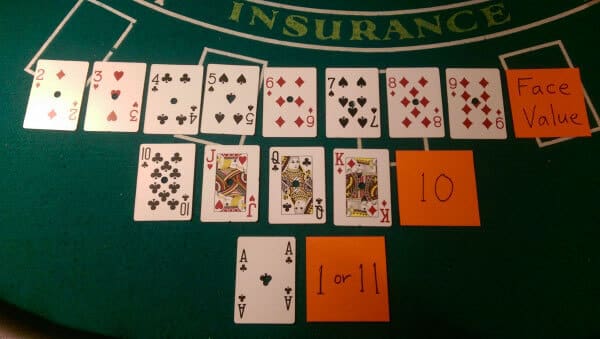
The Blackjack Tables’ Layout
Blackjack is usually played on a semicircular table that can accommodate varying numbers of players. The most common tables accommodate 7 players (or seven “spots”) but we’ve seen tables that only allow 5 players and other tables that have 12 spots! The dealer stands behind the table and chip rack and the players sit on the other side.
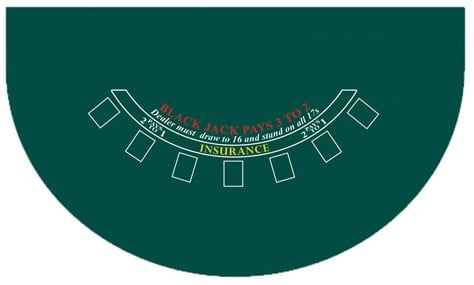
Playing Blackjack
Blackjack games come with many rule variations and different numbers of decks. The most common game of blackjack is dealt out of a 6-deck or 8-deck “shoe” (a plastic, card-dispensing device). Single and double deck games are still alive and well but not all casinos that have blackjack will have single and double deck so the “shoe games” are a little more common. Our example will be the procedure for the most common blackjack game played with 6 decks. Here is the basic overview of a round of blackjack:
- Player buys chips
- Player places a wager
- Dealer deals cards to players
- Player decides how to play hand
- Dealer plays hand
- Payouts
1. Player Buys Chips
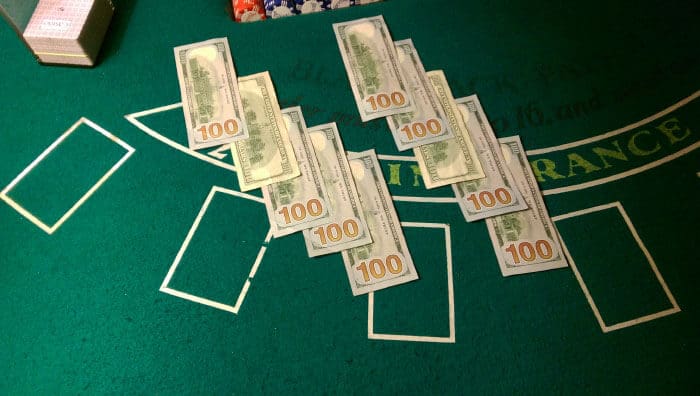
Before you can play at the table you need chips. Most casinos will not allow “cash plays” wagers anymore, so you will have to let the dealer exchange your money for casino chips. You do this by simply walking up to the table a placing your money on the felt of the table. Do not hand your money to the dealer (they won’t take it). For security reasons dealers cannot take anything out of a player’s hand or vice versa. Once you lay your money on the felt the dealer will lay it out on the table for the cameras to clearly see how much it is and a pit boss will come over and verify the amount. The dealer will count out chip denominations equal to the amount you’ve bought in for and push the chips toward you. You are now free to handle the chips and place your wager. The dealer will arrange your buy-in on the felt so the cameras can clearly see the amount. This is what buying in for $1000 looks like.
2. Player Places a Wager
At the start of a round the first thing you do is place a bet in the betting circle (sometimes it’s a square, or just a casino logo on the felt where your bet goes). The table will have a small sign on the far right or left side of the table telling you what the betting limits are. Most tables in the US will require a minimum of at least $5 per hand, but the minimum and maximum bet you can make will be different depending on what casino you go to and the regulatory environment where the casino is located.
3. Dealer Deals Cards to Players
After you place your bet the dealer will deal clockwise, one card, face up, to each player at the table and then one card face down for herself. Then she will deal one more card face up to each player and one more card for herself, face up. Each player has 2 cards, face up, in front of them, but the dealer has one card face up and one face down. It should look something like the picture below. Now it’s time to play the game!
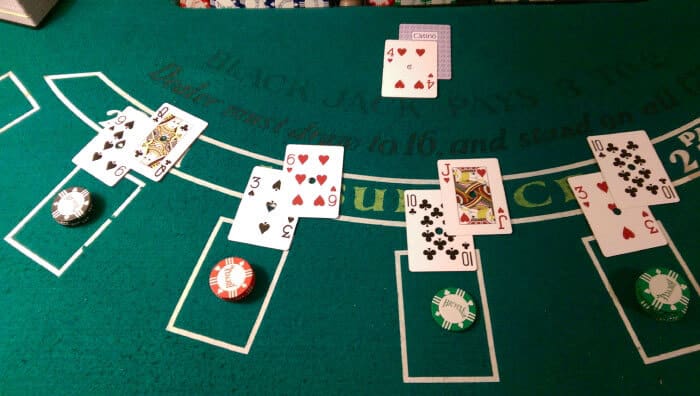
4. Player decides how to play hand
The dealer will start at the person on their left (also known as “first base”) and wait for that player to play their hand. You have two cards face up in front of your bet. To play your hand, first you add the card values together and get a hand total anywhere from 4 to 21. If you’re dealt a ten-value card and an Ace as your first two cards that means you got a Blackjack! Congratulations! Those get paid 3 to 2 (or 1.5 times your wager) immediately, without playing through the round, as long as the dealer doesn’t also have a Blackjack. If the dealer also has a Blackjack, you wouldn’t win anything but you also wouldn’t lose your original wager. This is called a “push”. If YOU don’t have a Blackjack AND the dealer doesn’t have a blackjack, your dealer will point to each player in succession and wait for you to decide how you want to play your hand. When it’s your turn, you will have to make your decision using the appropriate hand signal. Dealers will not respond to your verbal instructions because the cameras need to see your decisions as well. There are 5 ways you can play your hand:
Stand – If your first two cards are acceptable, you can stand and the dealer will move on to the next player. [Hand signal: Wave your hand or simply put out an open palm over the felt.]
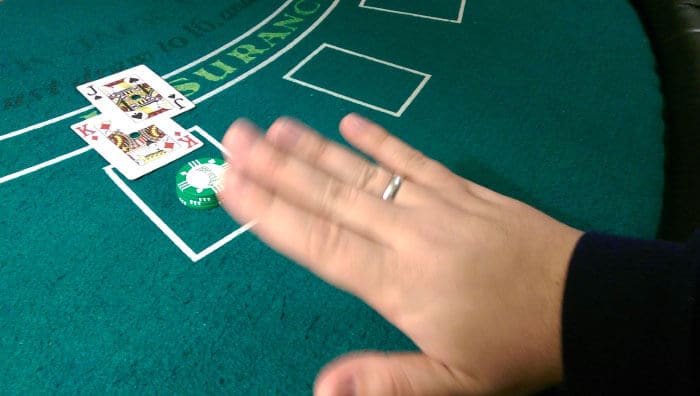
Hit – If you would like more cards to improve your hand total, the dealer will deal you more cards, one at a time, until you either “bust” (go over 21) or you choose to stand. There is no limit on the number of cards you can take (other than going over a total of 21). [Hand Signal: Tap the felt with your finger.]
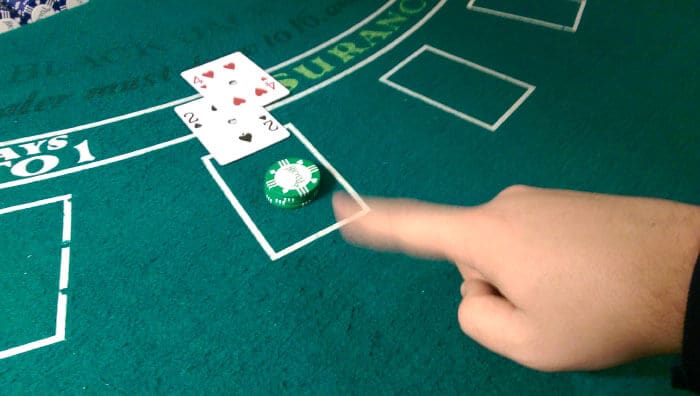
Double Down – If you have a hand total that is advantageous to you but you need to take an additional card you can double your initial wager and the dealer will deal you only 1 additional card. [Hand signal: Just put up a wager, equal to your initial wager, on the left side of your original bet and the dealer will give you one additional card, turned sideways to indicate you may not take additional cards.] Note: most casinos will also allow you to “double for less” meaning you don’t have to put up an equal wager to your original wager. However, mathematically speaking there is never a time when doubling for less is a better decision than doubling for the full amount, so we would discourage “doubling for less” even if the casino will let you.
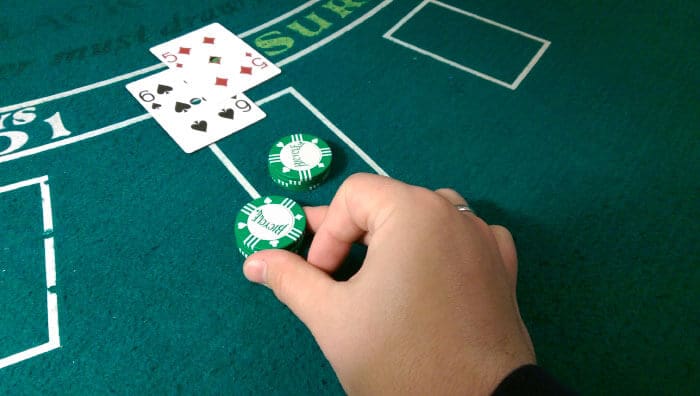
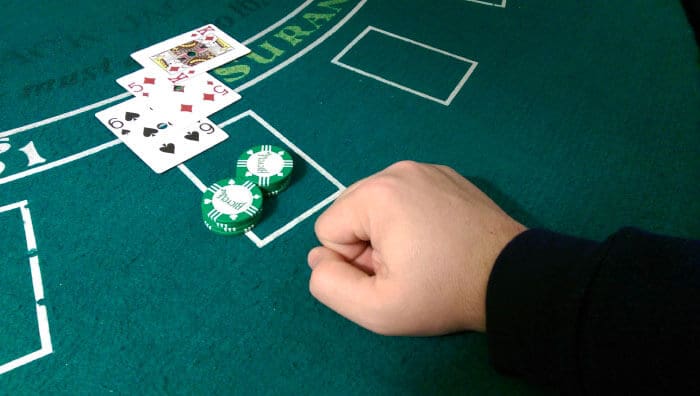
Split – If you’re dealt a pair (2 cards of equal value) you have the option to put out a second wager and the dealer will split the two cards so that each card will become the first card on two new hands. This also applies to face cards. You are allowed to split a hand consisting of a King and a Jack because they both have the same value, even though they are not actually a pair. [Hand signal: Put up a second wager equal to your first. Then give a “peace sign” to signify you would like to split and not double down. The dealer will make two hands out of your first hand and you will be dealt a second card on each.]
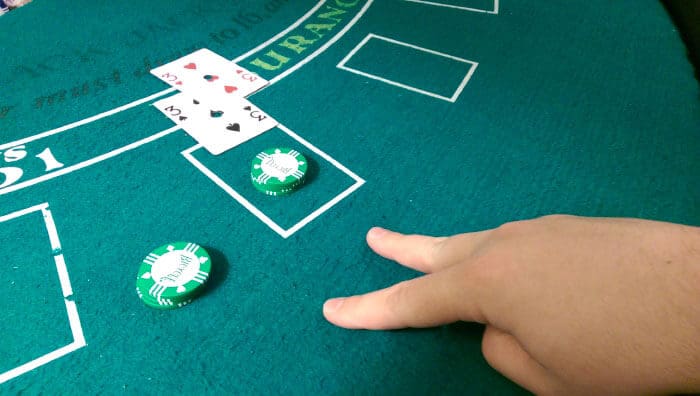
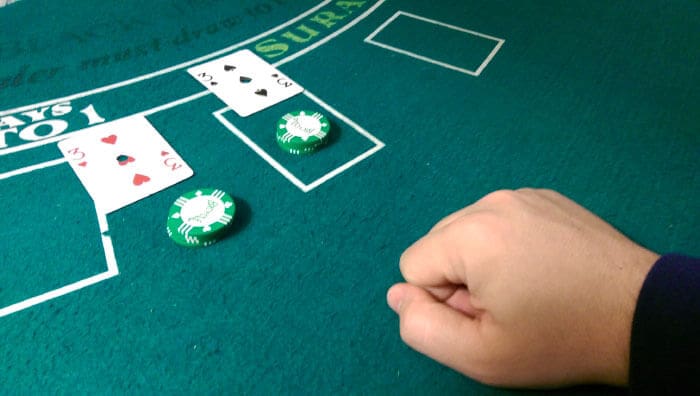
Surrender – If you don’t like your initial hand, you have the option of giving it up in exchange for half your original bet back. [Hand signal: draw a line across the felt behind your bet as if you were cutting a slit in the felt with an imaginary knife. It is common for dealers to mistake this signal for the “hit” signal. To be safe, always verbalize the word “surrender” to your dealer and then make the signal on the felt for the cameras.]
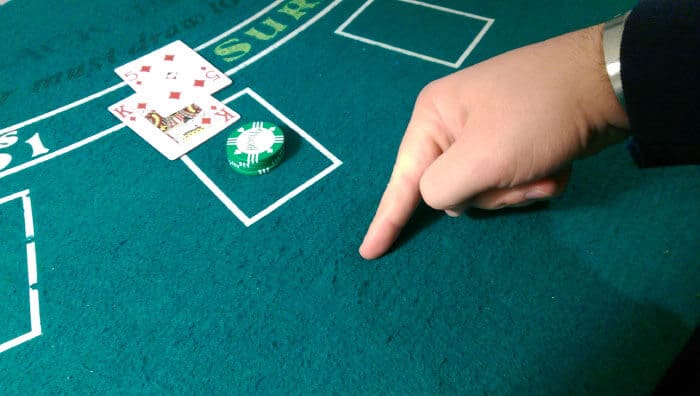
5. Dealer Plays Hand
I know what you’re thinking, “Oh my gosh, that’s a lot of options, how do I know which one is the best choice?” Well, that depends on the dealer’s “up-card” (the dealer card that is face up and visible to the players)
Basic Strategy
Based on what the dealer is showing, and what you have in your hand, you make the choice that follows basic strategy. Basic strategy is the mathematically optimal way to play for every combination of player hand and dealer up-card. It was created by a computer that played millions of rounds of blackjack and determined the best way to play each hand combination based on what worked out best for the player most often. If you follow basic strategy it takes the guesswork out of the decision! Phew!
Player Hand Resolution
When you follow basic strategy and play your hand by using one of the 5 options listed above, one of 3 things will happen.
- You Stood Immediately – You were dealt a hand that basic strategy says you should not take any cards on.
- You made a hand – You took more cards (hit, double or split) and achieved a hand total of 21 or less and did not bust.
- Your hand is out of play – You hit your hand one or more times and “busted” or you chose to surrender your hand. If your hand busts you immediately lose your wager. This is why the casino has an edge on the game. The player must act first, so that even if the dealer eventually busts like you did, they still keep your money because you busted first.
If your hand hasn’t busted, and you didn’t surrender, then it’s time for the dealer to play their hand. The dealer will first flip over their “hole card” (the face down card) and add up their 2-card hand. If the dealer has a hand total of 17 or higher, they will automatically stand. If the dealer has a hand total of 16 or lower, they will take additional hit-cards. Doubling, splitting and surrender are not available to the dealer and the dealer does not have any choice with how they play their hand like the player does. The Dealer must play their hand the same way every time. The only exception is when the dealer has a 17 that consists of an Ace and a six. This is called a “soft 17” and, depending on the casino, this hand is sometimes hit by the dealer because it can also count as a 7 (due to the flexible value of an ace), giving the dealer more chances to get a better hand than 17. This gives the casino a bigger advantage than if the dealer stands on ALL 17s. Whether or not the dealer will hit a soft 17 will usually be prominently displayed, in text on the the felt, so you know how to expect the dealer to play their hand. Again, dealers do not have the option to deviate from the rules set by the casino.
6. Payouts
Ok so you’re done playing your hand and the dealer is done playing their hand according to the restrictions above. One of 2 things will happen.
- The dealer will bust, and they will pay even money (1 times the wager) to each hand that is still in play on the table. or…
- The dealer will make a hand (17 through 21). If your hand is still in play, it’s a simple battle of who has the higher hand. If the dealer has the higher hand, they sweep your bet. If you have the higher hand, the dealer pays you one times your wager. If you and the dealer have the same hand-total, it’s considered a “push” and you keep your money but are not paid on your wager.
Now the round is over! That’s all there is to it. The cards get swept up and you start another round.

